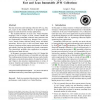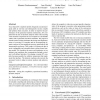OOPSLA
2015
Springer
8 years 7 months ago
2015
Springer
We present an efficient, modular, and feature-rich framework for automated generation and validation of complex structures, suitable for tasks that explore a large space of struc...
OOPSLA
2015
Springer
8 years 7 months ago
2015
Springer
The data structures under-pinning collection API (e.g. lists, sets, maps) in the standard libraries of programming languages are used intensively in many applications. The standar...
OOPSLA
2015
Springer
8 years 7 months ago
2015
Springer
Syntax-guided synthesis searches for an implementation of a given specification by exploring large spaces of candidate programs. Sketches reduce these search spaces, making synth...
OOPSLA
2015
Springer
8 years 7 months ago
2015
Springer
Aliasing is crucial for supporting useful implementation patterns, but it makes reasoning about programs difficult. To deal with this problem, numerous type-based aliasing contro...
OOPSLA
2015
Springer
8 years 7 months ago
2015
Springer
HTML5 applications normally have a large set of CSS (Cascading Style Sheets) rules for data display. Each CSS rule consists of a node selector and a declaration block (which assig...
OOPSLA
2015
Springer
8 years 7 months ago
2015
Springer
Imperative programming has great merits. As the ubiquitous style, it is familiar and its linear, step by step nature is favored by the human mind. Expert programmers, however, are...
OOPSLA
2015
Springer
8 years 7 months ago
2015
Springer
Many JavaScript programs are written in an event-driven style. In particular, in server-side Node.js applications, operations involving sockets, streams, and files are typically ...
OOPSLA
2015
Springer
8 years 7 months ago
2015
Springer
Trace-based JIT compilers identify frequently executed program paths at run-time and subsequently record, compile and optimize their execution. In order to improve the performance...
OOPSLA
2015
Springer
8 years 7 months ago
2015
Springer
We consider from a practical perspective the problem of checking equivalence of context-free grammars. We present techniques for proving equivalence, as well as techniques for fi...
OOPSLA
2015
Springer
8 years 7 months ago
2015
Springer
Understanding the run-time behaviour of object-oriented applications entails the comprehension of run-time objects. Traditional object inspectors favor generic views that focus on...


